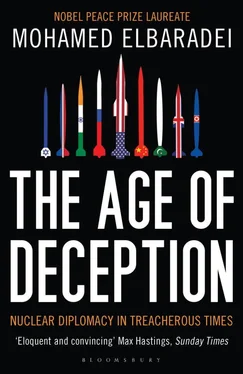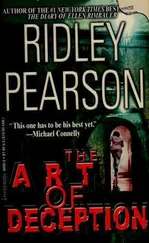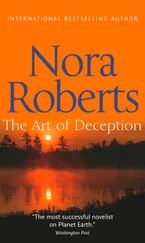The root of the discrepancy was this: the composition of the plutonium evident in the waste samples did not match with the plutonium product presented for verification. Blix, with his customary skill in using metaphors, likened the situation to finding a pair of gloves that did not match. From a technical point of view, this meant two things. First, there had to be another collection of waste, somewhere, that matched the verified product. Second, there had to be a stash of additional plutonium somewhere that we had not seen. A key problem was that we didn’t know what kind of quantity of “additional” plutonium we were looking for—grams or kilograms.
The North Koreans were clearly surprised by the sophistication of the Agency’s analysis. Our environmental sampling techniques had helped us to determine not only the correctness of the North Korean declaration but also whether it was complete.
Their story began to change. North Korea acknowledged that they had performed “one small experiment,” to which they attributed the mismatch shown by the IAEA analysis. But this explanation didn’t fit technically. The reactor in question, a five-megawatt experimental Magnox reactor of Soviet design, had begun operation in August 1985. From their forensic study of the samples, Agency experts were able to determine that the reprocessing of fuel from the reactor to separate plutonium had taken place over a longer duration and with more complexity than the North Koreans were admitting. The inspectors concluded that, during the seven years of the reactor’s operation, North Korea had probably reprocessed spent fuel on as many as three to four occasions, and certainly more than the “one small experiment” they were suggesting.
A second area of discrepancy had to do with the concealment of nuclear facilities. The Magnox reactor was located at Yongbyon, a site about one hundred kilometers north of Pyongyang, a 2.5-to-3.5-hour drive through villages, depending on the weather. The Agency was aware of a nuclear waste storage facility at the same site, referred to as Building 500. In addition, we had seen a series of satellite photos, provided by the United States, that showed the progressive concealment of a two-story building believed to be an additional nuclear waste facility. The North Koreans had ultimately placed the entire facility underground, covering it and planting the area with trees. Two high-explosive test sites also had been identified, one near the reactor at Yongbyon and another at a site twenty kilometers away.
In late August 1992, with anxiety mounting about the inadequate answers the North Koreans were providing, another inspection was conducted. Once again, the result was a mixture of cooperation and obfuscation.
The visit was coordinated by military personnel, much of it handled personally by the commandant of Yongbyon. The North Koreans seemed to be testing the inspectors, to see how much they knew. Our initial request to inspect the two waste sites and high-explosive test sites was met with a flat refusal; then the North Koreans relented and agreed to allow the inspectors to visit the Building 500 waste site as well as the high-explosive test sites. Full cooperation, however, proved elusive. On one occasion the handlers took the inspectors to the wrong location, and then appeared upset when the inspectors pointed out the error. In the end, our North Korean counterparts denied even the existence of the second waste location, insisting that it was only military bunkers and refusing access to the Agency inspectors.
During September and late October, with tensions rising, the IAEA held a number of meetings at its headquarters in Vienna with the North Korean minister of atomic energy, Choe Hak Gun, and the North Korean delegation. Each time the IAEA gave North Korea numbers that reflected the Agency’s analysis, the North Koreans would adjust their declaration accordingly. However, they still did not come up with what we considered a complete and correct declaration.
Finally, Blix decided to send me on a mission to Pyongyang, to lay out the discrepancies, press the North Koreans to be fully transparent, and urge them to bring a new, accurate declaration of their nuclear program to the IAEA, including the nuclear material and facilities we believed they had not yet revealed. In short, we were asking them to uphold their obligations under their safeguards agreement with the Agency; otherwise, we would have to call for a “special inspection,” the Agency’s tool of last resort to get access to suspect sites.
Thus the December 1992 visit was not exactly a friendly call; we had our work cut out for us. By that time, I had moved into the position of the IAEA’s director of external relations. I was accompanied by Sven Thorstensen, the Norwegian safeguards director responsible for North Korea, and Olli Heinonen, a Finn who worked for Sven at the time and who had been heavily involved in the initial inspections.
The discussions were torturous. The North Koreans proved to be formidable negotiators. There was a good cop/bad cop division of labor among the members of their delegation. Some accused us of being U.S. agents, and when I reacted sharply to this, they mumbled an apology. Others took a softer approach, and when that didn’t work, they yielded once again to their harsher colleagues. This routine was repeated on various topics. In the meantime, the North Korean media began attacking Blix and me, and the Agency as a whole, accusing us of being stooges for the Americans.
This continued for three grueling days. Each night, I called Blix from the hotel phone to tell him we were not making progress; and he answered that we needed to request a special inspection. We were certain that our hosts were eavesdropping on our conversations, so we discussed a special inspection as a way to put pressure on them.
By the final evening, it was clear that our visit had failed to achieve a breakthrough. We were invited to dinner with Deputy Foreign Minister Kang Sok Ju, where the North Koreans served us each a hamburger topped with a fried egg.
At the outset of the conversation, I asked the deputy foreign minister a question that was meant to be more conversational than provocative: “Why is it that your country has so much resentment toward the United States?”
The response was anything but casual. It turned into a forty-five-minute harangue, an extended history of North Korean relations with the United States dating back to the arrival of the USS General Sherman on the Korean Peninsula in the mid-1800s. The ship had steamed up the Taedong River to the outskirts of Pyongyang. In what was viewed as a heroic victory against foreign invaders, the locals burned the ship and killed all its crew. The great-grandfather of North Korea’s Great Leader Kim Il Sung had reportedly participated in that attack.
And so it went: while our food sat before us, untouched, the deputy foreign minister recounted every U.S.–North Korean interaction since that time. When he finally paused, I asked him, out of courtesy, a simple follow-up question. He continued for another fifteen minutes. The obsession was clear: North Korea was deeply entangled in a long-running struggle with the United States, certain that the Americans were bent on trying to change the regime.
At the end of this exchange, I looked down. Our fried eggs had turned a questionable shade of gray. But diplomacy offered little choice. We began to eat.
Back in Vienna, after further consultation, Blix made the decision to request a special inspection. This was an extremely rare move on the part of the Agency. It had been done only once before, in Romania, shortly after the fall of Nicolae Ceauşescu, when the new Romanian regime had itself requested a special inspection in an effort to further discredit the former Communist president. [1] Following Ceauşescu’s ouster, the new government requested a special inspection to show that, under Ceauşescu’s rule, Romania had reprocessed one hundred milligrams of plutonium without informing the IAEA.
In the case of North Korea, calling for a special inspection of the disputed waste facility would send a clear signal that the IAEA was upping the ante.
Читать дальше












